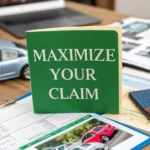If you’re asking yourself, ‘how do I file a diminished value claim?’ you’re not alone. Your car may look perfect after repairs, but its value has dropped — and you can recover that loss if another driver was at fault. Your car has been repaired after an accident and it looks great, but its value has permanently dropped. This loss in resale value is called diminished value, and if another driver was at fault, you are entitled to compensation. Filing a successful claim requires knowing how to prove your loss with evidence the at-fault driver’s insurance company can’t ignore.

Why You Need to Build a Strong Case
Insurance companies don’t willingly pay for diminished value. They often count on vehicle owners not knowing their rights or lacking the proof needed to support a claim. A successful diminished value claim isn’t about arguing with an adjuster; it’s about presenting undeniable facts. Your goal is to build a rock-solid case from day one, starting with the essential documents that tell your vehicle’s story.
The Essential Documents for Your Claim and learn how do I file a diminished value claim?
Before you contact the insurance adjuster, you need a file that clearly outlines the accident, the repairs, and your vehicle’s condition before the crash. This documentation removes guesswork and forces the insurer to address the facts of your financial loss. A well-documented claim is your most powerful negotiating tool. It shows the adjuster you’re serious, organized, and prepared to prove your vehicle’s true loss in value.
To get started, use this checklist to gather the core items that form the foundation of your diminished value claim.
Diminished Value Claim Starter Checklist
Here’s a quick rundown of the must-have items you need to begin building your claim.
| Document or Information | Why It’s Essential | Where to Find It |
|---|---|---|
| Official Police Report | Establishes who was at fault, a key requirement for a DV claim. | The law enforcement agency that responded to the accident. |
| Finalized Repair Invoice | Shows an itemized list of all parts and labor, proving the severity of the damage. | The auto body shop that completed your repairs. |
| Proof of Payment | Confirms that all repairs have been completed and paid for. | Your bank statement, credit card receipt, or a paid-in-full receipt. |
| Photos of the Damage | Provides powerful visual evidence of the collision’s impact before repairs. | Your smartphone’s photo gallery from the day of the accident. |
With these items in hand, you’re ready for the next step: getting a professional appraisal. A certified appraisal report provides the final piece of evidence you need to anchor your claim. At SnapClaim, we back our process with a money-back guarantee: if your insurance recovery is less than $1,000, we’ll refund your appraisal fee completely.
Confirming Your Eligibility and Understanding Fair Market Value

Before you file a diminished value claim, you must first confirm you have a strong case. Getting this right from the start saves time and helps set realistic expectations. This is the first step to learn how do I file a diminished value claim?
You are generally eligible if three key things are true:
- You were not at fault for the accident.
- Your vehicle suffered significant structural or cosmetic damage.
- The claim is filed against the at-fault driver’s insurance policy, not your own.
If you meet these criteria, your next task is to prove your vehicle’s true fair market value before the crash.
Why Pre-Accident Condition is So Important
Your car’s value right before the collision is the baseline for your entire claim. The insurance adjuster will consider several factors to determine this number, but their goal is often to keep that value as low as possible.
You need to think like an appraiser and consider what gave your car its real-world value:
- Age and Mileage: A newer, low-mileage car will suffer a much larger drop in value than an older vehicle with high mileage.
- Condition: Was your car in excellent shape? A clean interior, no prior dings, and a flawless finish all matter. Service records and pre-accident photos are your best evidence here.
- Special Features: Premium trim packages, custom wheels, or a high-end sound system all increase your car’s pre-accident value.
The core of your claim is proving the difference between your car’s fair market value one minute before the crash and its value one minute after the repairs were completed. An accident history permanently damages your vehicle’s reputation, and that’s where the real loss occurs.
Moving Beyond the Insurer’s Biased Formulas
Insurance companies often use generic, one-size-fits-all formulas to calculate diminished value. Unsurprisingly, these formulas almost never reflect your car’s actual loss in market value.
This is why an independent, certified appraisal is so powerful. It replaces their biased calculation with a detailed, market-based analysis that holds up under scrutiny. Our guide on navigating car accident diminished value claims breaks this down further. An independent appraisal from SnapClaim provides the objective proof needed to counter a lowball offer, clearly showing your actual financial loss and strengthening your position to negotiate.
Building Your Evidence File with the Right Documents

A diminished value claim is won with proof, not arguments. Insurance companies operate on documentation, and a disorganized or incomplete file is the quickest way to a lowball offer or denial. Your mission is to build an evidence file so airtight that it leaves the adjuster no room to dispute your claim. You are telling the complete story of your vehicle: its value before the accident, the true extent of the damage, and the quality of the repairs.
Your Non-Negotiable Paper Trail
Let’s start with the absolute essentials. These documents establish the basic facts of your case.
Your starting checklist must include:
- The Official Police Report: This is your primary document for establishing who was at fault. You can get a copy from the police department or highway patrol that responded to the accident.
- The Finalized Repair Invoice: This is more than a bill; it’s a detailed list of every part replaced and every hour of labor spent, proving the repairs were significant.
- Proof of Payment: A receipt or bank statement showing the repair bill was paid confirms the work is done.
These three documents form the foundation of your claim, but to get what you’re owed, you can’t stop there.
Adding Depth with Supporting Evidence
The core documents get your foot in the door, but supporting evidence paints the full picture of your loss. This is where you separate yourself from the average claimant and show the adjuster you mean business. These details prove your vehicle’s excellent pre-accident condition and value.
An adjuster’s job is to minimize payouts. Your job is to make that impossible by providing a mountain of credible evidence. The more proof you have, the less they can argue.
Round out your file with these powerful items:
- High-Quality Photos (Before and After): Visuals are incredibly persuasive. Photos of the wreck show the severity of the impact. Post-repair photos show the final result.
- Pre-Accident Service Records: Did you keep up with maintenance? Pull those records. They prove you were a responsible owner and the vehicle was in top mechanical shape.
- Vehicle History Report: A clean pre-accident Carfax or AutoCheck report is a huge asset, showing no prior accidents that could have already lowered its value.
Gathering this information creates a clear, compelling narrative that strengthens your position. To see how these factors contribute to the final calculation, read our guide on what vehicle diminished value truly is. Once your evidence file is complete, you are ready for the most critical piece of your claim: a certified appraisal.
Why a Certified Appraisal Is Your Strongest Asset
After an accident, the at-fault driver’s insurance adjuster is not on your side. They will likely use a generic, internal formula—often the notorious “17c method”—to calculate your car’s diminished value. This cookie-cutter calculation almost never reflects what your car has actually lost in real-world market value and is designed to produce a lowball offer.
This is where you flip the script. An independent, certified diminished value appraisal is the single most powerful tool you have. It shifts the conversation away from the insurer’s biased worksheet and puts hard, undeniable facts on the table.
The Power of Unbiased Proof
An insurance company’s valuation is self-serving. They have a direct financial incentive to pay as little as possible. An independent appraisal, however, is an unbiased, third-party assessment focused on determining your vehicle’s true loss in value.
A comprehensive appraisal report from an expert like SnapClaim is built on solid data. It provides a deep market analysis, direct comparisons to similar undamaged vehicles, and a clear, defensible calculation of your car’s lost value. This is the kind of evidence that turns your request into a professional demand.
When you present a certified appraisal, you are no longer just asking for money—you are demonstrating a quantifiable financial loss backed by expert analysis. This fundamentally changes the negotiation dynamic.
This professional documentation signals to the adjuster that you’re serious and have done your homework. For a closer look at what makes an appraisal report so effective, see our certified auto appraisal guide.
A Risk-Free Step Toward a Fair Payout
Investing in a certified appraisal can feel like another expense, but it’s a strategic move that more than pays for itself. Without it, you are often forced to accept whatever number the insurer offers. With it, you have the proof needed to negotiate for a settlement that actually makes you whole.
To make this an easy decision, SnapClaim offers a money-back guarantee. If the insurance recovery from your diminished value claim is less than $1,000, we will fully refund your appraisal fee. This removes the financial risk, allowing you to pursue your claim with total confidence.
Submitting Your Claim and Negotiating with Confidence
You’ve done the hard work. Your evidence is organized, and your certified appraisal is in hand. Now it’s time to submit your claim and negotiate a fair settlement.
This is where your preparation pays off. The submission process is straightforward, but how you frame your demand—and handle the negotiation—makes all the difference.
Making Your Formal Demand
First, you’ll need to draft a professional demand letter. This is a clear, concise summary of your case.
Be sure to include:
- Your name and the at-fault driver’s name
- The insurance claim number
- The date of the accident
- The exact diminished value amount you are demanding, supported by your SnapClaim appraisal.
Attach copies of all your evidence: the police report, final repair invoices, and of course, your certified appraisal. Send this complete package to the at-fault driver’s insurance adjuster. This professional approach shows you are serious and have the facts to prove your loss.

As you can see, every piece of documentation builds upon the last, setting you up for a successful negotiation.
Preparing for the Negotiation
Once the adjuster receives your demand, the negotiation begins. Be prepared for them to push back—it’s their job to minimize payouts. They may question your appraisal’s methodology, counter with a lowball offer based on a vague “internal formula,” or dismiss the concept of diminished value altogether.
Don’t get frustrated. This is where your certified appraisal becomes your shield.
When the adjuster challenges you, stay calm and professional:
- If they give you a lowball number: Ask for a detailed, written breakdown of how they calculated that figure.
- If they question your appraisal: Remind them it was prepared by a certified, unbiased expert using real-time market data.
- If they stall or ignore you: Follow up consistently in writing. Email is your best friend, as it creates a clear paper trail.
The secret is to keep the conversation focused on the facts. Your claim is based on a quantifiable financial loss, not emotion. Stick to the data in your appraisal and don’t let them drag you into an argument.
You are in a position of strength because you have the proof. For more tactics, check out our guide on how to file a diminished value claim. Remember, our appraisal is backed by a money-back guarantee. If your insurance recovery is under $1,000, we’ll refund the fee. You have nothing to lose by demanding what you’re rightfully owed.
FAQ: Common Questions About Diminished Value Claims
What if my car is declared a total loss?
If your vehicle is deemed a total loss by your insurer, you cannot file for diminished value. This claim compensates for decreased resale value after repairs, but in a total loss, the insurer pays the actual cash value (ACV) before the accident. The notion of “resale value” is irrelevant here. Total loss claims now comprise over 22% of collision claims due to rising repair costs and older vehicles. For more information, visit these industry insights.
Can I file a diminished value claim if I was at fault?
Typically, no. Diminished value claims are filed against the at-fault driver’s insurance, as their negligence caused the financial loss. Your insurance, as first-party coverage, usually excludes this. Our guide on diminished value claims provides further details.
Can I file a diminished value claim if I was at fault?
Typically, no. Diminished value claims are filed against the at-fault driver’s insurance, as their negligence caused the financial loss. Your insurance, as first-party coverage, usually excludes this. Our guide on diminished value claims provides further details.
How long does the claim process usually take?
The process can take 30 to 90 days, depending on:
The Insurance Company: Response times vary.
Claim Complexity: Straightforward cases resolve faster than disputed ones.
The Negotiation: Discussions with the adjuster can extend the timeline.
Keep records of all communications with the adjuster. A professional appraisal from SnapClaim may expedite the process.
reference : How do I file a diminished value claim
About SnapClaim
SnapClaim is a premier provider of expert diminished value and total loss appraisals. Our mission is to equip vehicle owners with clear, data-driven evidence to recover the full financial loss after an accident. Using advanced market analysis and industry expertise, we deliver accurate, defensible reports that help you negotiate confidently with insurance companies.
With a strong commitment to transparency and customer success, SnapClaim streamlines the claim process so you receive the compensation you rightfully deserve. Thousands of reports have been delivered to vehicle owners and law firms nationwide, with an average of $6,000+ in additional recovery per claim.
Why Trust This Guide
This article was reviewed by SnapClaim’s team of certified auto appraisers and claim specialists with years of experience preparing court-ready reports for attorneys and accident victims. Our content is regularly updated to reflect the latest industry practices and insurer guidelines.
Get Started Today
Ready to prove your claim? Generate a free diminished value estimate in minutes and see how much you may be owed.
Get your free estimate today





